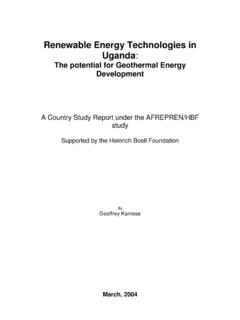Transcription of Vermont Yankee's Decommissioning As An ... - leg.state.vt.us
1 Vermont Yankee's Decommissioning As An Example of Nationwide Failures of Decommissioning Regulation Comments Submitted to the NRC March 23, 2015 Re: Entergy Nuclear Operations, Inc., Vermont Yankee Nuclear Power Station Post-Shutdown Decommissioning Activities Report Prepared By: Fairewinds Energy Education Corp Burlington, VT 05401 Page 2 of 35 Executive Summary: Fairewinds concludes that weak NRC nuclear power plant Decommissioning regulations have not created a solid financial and technical foundation to protect the public's health and welfare, but rather are a financial subsidy for the nuclear industry. We believe that the patchwork structure of NRC regulations creates a series of subsidies designed to minimize each energy corporation's cost to shut down nuclear power plants and marginalize Decommissioning efforts for decades into the future, creating an intergenerational transfer of risk. Nuclear power corporations, including, but not limited to Vermont Yankee, are using available NRC legal precedents to distort the true cost of nuclear power and minimize the actual safety risks that exist in the Decommissioning of each corporation's aging reactors.
2 The results of Fairewinds analysis are delineated in the sections below. This report is divided into two broad areas: financial issues and safety issues. The first area, Financial Issues, has significant national ramifications and is also inextricably intertwined with safety concerns relating specifically to the Decommissioning of Vermont Yankee. Were it not for the financial incentives that the Nuclear Regulatory Commission has built into its regulations, nuclear plants would be promptly dismantled and Fairewinds' concerns regarding Vermont Yankee's ongoing safety issues with its carcass proposed to remain untended in Vermont for at least 60-years would no longer exist. Fairewinds Energy Education received a grant from the Lintilhac Foundation to analyze Entergy's proposed plans for Decommissioning the Vermont Yankee Nuclear Power Plant located in Vernon, Vermont . Fairewinds found it impossible to analyze Entergy's proposed Decommissioning plans for Vermont Yankee without also concurrently analyzing the Rules and Regulations of the United States Nuclear Regulatory Commission (NRC).
3 Page 3 of 35 Table of Contents EXECUTIVE SUMMARY: PART 1: FINANCIAL ISSUES: 1. THE CONCEPT OF SAFSTOR 4 2. THE COST FORMULA FOR Decommissioning ESTIMATES 7 3. INDEPENDENT SPENT FUEL STORAGE INSTALLATION FACILITY (ISFSI) COSTS 11 4. SPENT FUEL STORAGE 16 S. GROWTH PROJECTIONS FOR THE Decommissioning FUND 18 6. LLC STATUS - NRC AND ENTERGY STATEMENTS 20 7. SHARING OF EXCESS Decommissioning FUNDS 24 8. AUDITING THE EXPENDITURES FROM THE FUND 26 PART 2: SAFETY ISSUES: 28 FINALLY FOUR GLARING SITE SPECIFIC ISSUES HAVE BEEN IDENTIFIED BY FAIREWINDS. 29 1ST) EMERGENCY PLANNING 29 2ND) REMOVAL OF THE FUEL IN Vermont Yankee's SPENT FUEL POOL 31 3RD) STRONTIUM CONTAMINATION ON-SITE 32 4TH) SITE RELEASE CRITERIA 34 CONCLUSION: 35 EXHIBIT LIST: 35 2 3 Part 1: Financial Issues: The Federal Code of Regulations 10 CFR is the foundation of the NRC's regulations covering nuclear power plant Decommissioning .
4 There are eight critical financial issues associated with Decommissioning nuclear power plants that stem from problems with the NRC's legal interpretation of 10 CFR These issues are: 1. The Concept Of SAFSTOR 2. The Cost Formula For Decommissioning Estimates 3. Independent Spent Fuel Storage Installation Costs (ISFSI) 4. Spent Fuel Pool Storage 5. Growth Projections For The Decommissioning Fund 6. LLC Status NRC And Entergy Statements 7. Sharing Of Excess Decommissioning Funds 8. Auditing The Expenditures From The Fund Page 4 of 35 1. The Concept Of SAFSTOR The Code of Federal Regulations, 10 CFR provides for three Decommissioning options: rapid dismantlement, permanent entombment, and an intermediate concept called SAFSTOR. While permanent entombment has not yet been applied in the United States, and rapid dismantlement has been initiated occasionally, the new Decommissioning option of choice for the nuclear industry has suddenly become SAFSTOR.
5 Memorialized in 10 CFR , the SAFSTOR approach to Decommissioning allows an energy corporation to wait 60 years before it must completely dismantle the mothballed nuclear plant. It is important to note that there is no basis in physics that led to this arbitrary conclusion that 60 years is an acceptable amount of time to wait to decommission a nuclear power plant. In reality, SAFSTOR is a financial mechanism designed to allow nuclear power plant owners to avoid paying for Decommissioning costs as the plant operates, effectively creating an intergenerational transfer of risk and costs. Instead, SAFSTOR allows these corporations that may or may not even exist in 60 years to place inadequate funds in the volatile financial market in hopes that those funds will grow during the 60-year Decommissioning hiatus to cover the astronomical costs of Decommissioning . Reasons that the Decommissioning costs have grown so astronomically are that inadequate funds were set aside initially, no effort has been made to ascertain current costs and make up differences, and most of these aged nuclear plants are leaking various radioactive isotopes that will necessitate even further costly cleanup.
6 The nuclear industry vehemently argues that SAFSTOR really is not a financial mechanism, and claims instead that it is a method by which to protect corporation personnel from exposure to increased doses of radiation by waiting 60 years to decommission the plant. While it is true radioactive material decays over time, the benefits of dose reduction are largely accrued during the first 10 years after a nuclear plant shut downs. Cobalt-60 is the primary isotope causing significant exposure to personnel during the first 10 years after shutdown. Since Cobalt-60 has a 5-year half-life, only 25% of Cobalt-60 remains after 10 years. Therefore, the benefit of waiting to Pages of 35 decommission for 10 years is that radiation exposure to workers from Cobalt-60 will be reduced by 75%, due to radioactive decay over that first decade. The latest claim made by the nuclear industry is that by waiting 60 years, the collective exposure to nuclear personnel should be minimized to slightly more than 300 Rem.
7 Truthfully, the actions of the nuclear industry while nuclear plants are operating belie industry claims regarding dose reduction to personnel. An illustrative example occurred in 2014 during a routine outage at the Entergy owned Palisades nuclear plant in Michigan. Entergy had shut down Palisades for routine maintenance and its regularly scheduled refueling outage. With long-standing and chronic aging management problems, Entergy finally decided to make a major repair while still maintaining an extraordinarily short refueling outage schedule. Entergy thus exposed 192 of its employees and independent contractors to very high levels of radiation in order to get the Palisades nuclear plant back into operation again as quickly as possible. The exposure to Entergy employees and contractors at the end of the three week long rushed outage was approximately 115 However, once Palisades was again generating electricity, profits were also flowing to Entergy.
8 While the nuclear industry continues to claim that employee and contractor exposure should be minimized during Decommissioning to a collective maximum of 300 Rem during or after 60-years of SAFSTOR, the same industry has no remorse regarding high levels of radiation exposure when returning a nuclear plant to the profitable status of generating electricity leads to a collective 115 Rem exposure in only three weeks. It is apparent then the nuclear industry and the NRC have used the SAFSTOR option to create a double standard for dose reduction during Decommissioning compared to operation. By allowing underfunded escrow accounts during the lifetime of an operating nuclear Person-rem Physics measurement of radiation exposure radiation: Units for measuring ionizing radiation For expressing the collective dose to a population, the person-Sv and person-rem are the units used. These units represent the product of the average dose per Page 6 of 35 power plant the NRC facilitates the reduction in nuclear production costs.
9 By enabling the power companies to present perceived lower nuclear power costs actually creates a subsidy for the nuclear power industry and allows nuclear power to appear to be a more competitive method of generating electricity when compared against other electric generating alternatives. At every step in the nuclear fuel chain, Decommissioning costs have exceeded available funds. These extra bidden costs, like the production of mill tailings from the mining of uranium in Moab, Utah, and Decommissioning of all nuclear facilities in the nuclear fuel chain are called externalities. The externalities of Decommissioning , including the cleanup from leaking plants and their dismantlement, and the cost of mining, milling, and fuel fabrication Decommissioning (after mining, milling, and fuel fabrication) are not factored into the price of nuclear power per kilowatt-hour when compared with other energy production like solar, wind, geothermal, wave, etc.
10 Recommendations: Fairewinds believes that the Nuclear Regulatory Commission should remove the SAFSTOR 60-year option from 10 CFR Although Decommissioning and dismantlement may not be entirely feasible in a short amount of time at some rare locations, the economics show that allowing 60-years before Decommissioning is merely a hidden nuclear power subsidy that has been memorialized into nuclear law in an effort to shift costs from the federal government's regulation of energy companies to the residents of the states in which the nuclear plants have been built. Fairewinds believes that the methods used by the NRC to accrue Decommissioning trust funds at all nuclear facilities, not just power reactors, needs to be completely revised to reflect the actual costs without allowing additional time for delayed cleanup. Present NRC methodology effectively creates a generational transfer of costs and risks.






